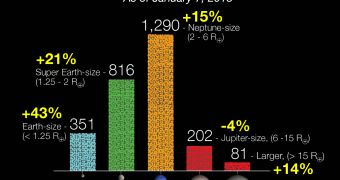The Kepler Space Telescope, which is keeping an eye on a relatively small portion of the sky to check for exoplanets, has now officially discovered 461 new planet candidates, in the last year. This means that in less than four years, Kepler has discovered 2,740 alien planet candidates around 2,036 stars.
In fact, the data released up to now only covers observations from May 2009, when the craft became operational, to March 2011. Kepler has been collecting data since then, but the huge volume means parsing and understanding it takes time.
These candidate planets haven't been yet confirmed, which means they could still turn out to be false signals. In total, Kepler has discovered 105 confirmed exoplanets.
To consider an exoplanet confirmed, astronomers have to observe it three times, meaning it has to make three orbits around its star.
Since Kepler hasn't been around for that long, only planets with short "years" have been confirmed, but, in time, those with longer orbits will eventually be confirmed as well.
Since the last data release, which covered everything up to September 2010, there's been a 20 percent increase in the number of candidates.
The number of Earth-like planets has also increased. The number of Earth-sized planets increased by 43 percent to reach 351. The number of super Earth-sized planets, as much as twice the size of the Earth's radius, increased by 21 percent to 816.
Still, the largest number of planet candidates found so far are Neptune-sized, i.e. two to six times the size of the Earth, which grew by 15 percent to 1,290. The number of stars with more than one planet around them rose from 365 to 467.
Again, all of this is based on data from the first 22 months of the mission and the increase is based on just six months of data.
The space telescope has been operational for 43 months now, when that data becomes available, the number of planet candidates and confirmed planets should go up dramatically.
And all of this comes from observing just 150,000 stars in our galaxy. There are 100 billion or as many as 200 billion stars in the Milky Way. Using older Kepler data, some scientists estimated that there are at least 100 billion planets in our galaxy.

 14 DAY TRIAL //
14 DAY TRIAL //